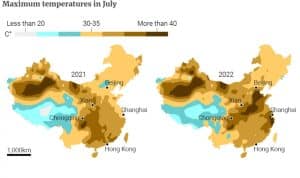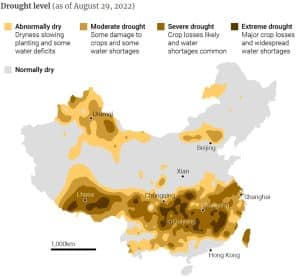Background
In 2023, the world experienced an unprecedented wave of extreme weather events, including devastating wildfires and record-breaking heatwaves. These events highlighted the severe impact of climate change, with China being notably affected. Various regions in China faced historic levels of heat, leading to widespread health concerns and economic disruptions.
The trend continued into the first half of 2024, with even more extreme weather patterns. China saw prolonged droughts in some regions and intense flooding in others, further exacerbating the challenges posed by climate change. These recent events underscore the urgent need for comprehensive policy improvements to mitigate the effects of climate change and protect vulnerable communities.
The Science Behind Climate Change
Climate change is primarily driven by the burning of fossil fuels such as coal, oil, and natural gas, which release greenhouse gases like carbon dioxide (CO₂) and methane (CH₄) into the atmosphere. These gases trap heat, causing global temperatures to rise in a phenomenon known as the greenhouse effect. Human activities such as deforestation, industrialization, and large-scale agriculture have significantly accelerated this process.
The consequences of global warming are severe and wide-ranging. Rising temperatures contribute to the melting of polar ice caps and glaciers, leading to rising sea levels that threaten coastal communities. More frequent and intense natural disasters, such as hurricanes, wildfires, and heatwaves, are becoming the norm. Additionally, the disruption of ecosystems is causing the extinction of numerous species, further destabilizing the planet’s biodiversity.
Climate Change Impacts in China
In 2023, China experienced the acute consequences of climate change. During the summer months, temperatures soared above 40 degrees Celsius (104 degrees Fahrenheit) in many cities, leading to widespread heat exhaustion and fatalities, particularly among vulnerable populations. The economic impact was substantial, with disruptions to agriculture and energy production causing higher prices and reduced availability of essential goods for consumers. Prolonged droughts in some regions and severe flooding in others further strained resources and infrastructure, underscoring the urgent need for climate resilience and adaptation measures.

Scorching Temperatures
A brutal heatwave ravaged much of China for over 70 consecutive days, with sustained temperatures exceeding 40 degrees Celsius (104 degrees Fahrenheit). This relentless heatwave affected more than 900 million people across at least 17 provinces, from southwestern Sichuan to the coastal regions of Jiangsu and Zhejiang in the east.
Severity of Drought
China faced an intense and prolonged drought that affected approximately half of its landmass, predominantly in the southern regions. The drought was so severe that sections of the Yangtze River, the country’s largest and most vital waterway, reached their lowest levels since at least 1865. This dramatic drop in water levels disrupted irrigation systems, hindered agricultural production, and posed serious threats to water supplies for millions of people. In many areas, reservoirs and lakes shrank drastically, leading to water shortages and forcing local authorities to implement stringent water rationing measures. The ecological impact was also profound, with diminished river flows threatening aquatic ecosystems and the biodiversity that depends on them.
Environmental and Economic Challenges
China’s environmental crisis is a consequence of decades of rapid industrialization. As the world’s largest emitter of greenhouse gases, responsible for over a quarter of global emissions annually, China faces significant environmental challenges, including severe air pollution, water scarcity, and soil contamination. These issues threaten the health and livelihoods of its 1.4 billion people and complicate global efforts to address climate change. The economic impact is also profound, with pollution and resource depletion undermining sustainable growth and necessitating costly remediation efforts.

Key Data on Climate Change in China
- Highest Annual Emissions: China has been the highest annual emitter of greenhouse gases for the past decade.
- Coal Production and Consumption: As the world’s largest producer of coal, China accounts for approximately half of global coal consumption.
- Coal-Fired Power Plants: In 2020, newly built coal-fired power plant capacity in China exceeded three times the total for the rest of the world combined.
- Extreme Weather Events: The frequency and severity of extreme weather events, such as floods, droughts, and heatwaves, have increased, causing significant economic and social disruptions.
- Glacier Retreat: Chinese glaciers, particularly those in the Tibetan Plateau, have been rapidly retreating, signaling rising temperatures and changing climatic patterns.
- Sea-Level Rise: Rising sea levels pose a significant threat to China’s extensive coastline, endangering major cities like Shanghai and Guangzhou.
- Continued Heatwaves: The first half of 2024 saw prolonged heatwaves, exacerbating health issues and straining energy resources.
- Worsening Droughts: Persistent drought conditions continued to affect large areas, particularly in southern China, further lowering water levels in major rivers and reservoirs.
- Increased Flooding: Early 2024 also witnessed severe flooding in multiple regions, leading to widespread displacement and damage to infrastructure.

Advocacy for Policy Improvement
To effectively address these challenges, it is crucial to advocate for the enhancement and robust implementation of climate policies. The Chinese government has introduced several measures aimed at reducing emissions and preventing further environmental degradation, including ambitious targets for renewable energy adoption, stricter emissions standards, and initiatives to promote reforestation.
However, translating these commitments into concrete actions remains challenging. Issues such as regulatory enforcement, coordination across various governmental levels, and balancing economic growth with environmental sustainability complicate these efforts. Continuous advocacy, public awareness, and international cooperation are essential to ensure that these policies are not only implemented but also achieve their intended impact in mitigating climate change and protecting the environment.
Recommendations for Policy Improvement
- Strengthen Renewable Energy Initiatives: Promote the adoption of renewable energy sources such as wind, solar, hydro, and nuclear power. Reduce reliance on coal by investing in clean energy technologies and infrastructure.
- Enhance Reforestation Programs: Expand large-scale reforestation and afforestation programs to increase forest coverage and restore degraded lands. The “Great Green Wall” project, aimed at combating desertification by planting trees across northern China, should be scaled up.
- Advance Clean Technology: Support research and development in clean technology, including electric vehicles (EVs) and energy storage systems. Implement policies to promote the adoption of EVs and invest in battery technologies.
- Improve Climate Resilience: Develop and implement strategies to enhance resilience to extreme weather events, such as floods, droughts, and heatwaves. This includes building infrastructure that can withstand these events and developing early warning systems.
- Increase Public Awareness: Raise awareness about climate change and its impacts through education and public campaigns. Encourage community participation in climate action initiatives.
Conclusion
The climate crisis serves as a stark warning of the urgent need to address climate change. The consequences of inaction are too great to ignore. By advocating for the improvement and effective implementation of climate policies, we can help ensure a safer and more sustainable future for ourselves and future generations. Taking bold action now is imperative to mitigate the effects of climate change and protect the planet.
Call to Action
China Development Brief (CDB)urges all stakeholders, including government authorities, businesses, and the public, to join forces in advocating for policy improvements and taking concrete actions to combat climate change. Let us work together to build a resilient and sustainable future for China and the world.



